
The Life and Times of Hubert Brooks M.C. C.D.
A Canadian Hero

 |
|
 |
Immediately upon release from solitary confinement at DuLag Luft I set out for the LAMSDORF prison camp (StaLag VIII B ) near Oppeln on the River Oder in Silesia.
We remained at DuLag Luft for two more days then set out for the LAMSDORF prison camp (StaLag VIII B ) near Oppeln on the River Oder in Silesia.
P/O Creighton however went to prison camp SAGAN.
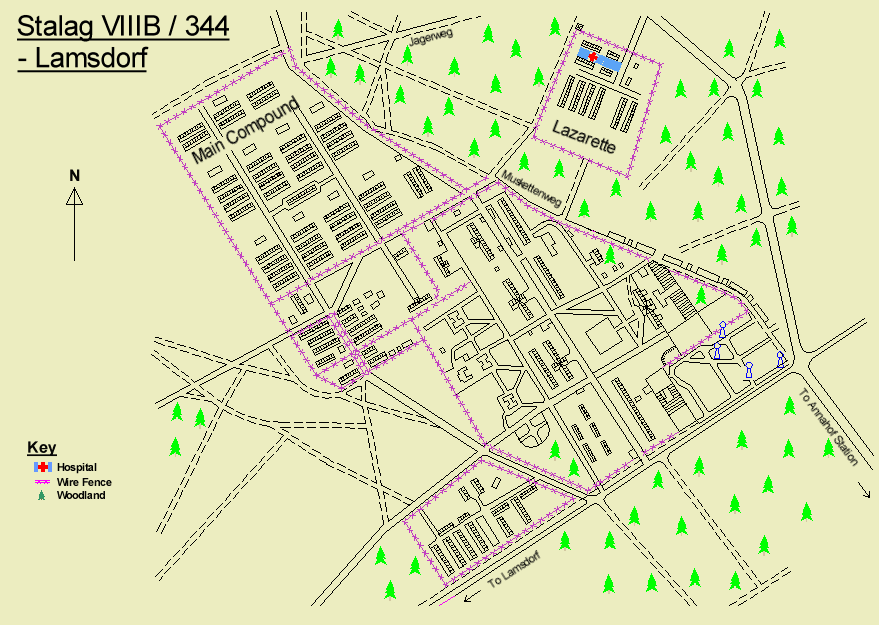
On 15th April 1942, after an exhausting rail journey we arrived at a train station about 3km from LAMSDORF / StaLag VIII B - the so-called worst Stalag of them all.
In fact StaLag VIIIB Lamsdorf was said to be the largest Stalag in the Third Reich.
As the train car cattle-truck-like doors opened, most prisoners were blinded by the sudden light and rolled onto the platform as they tried to recover use of their legs.
We were riffle-but prodded to form lines of five, to be counted and then recounted again.
We then had a slow, staggered 3km march to the single-bar barrier marking the entrance to Stalag VIIIB.
To the left was a guardhouse, to the right a stone eagle perched on top of a swastika.
Wilkommen bei Stalag VIII-B
StaLag VIII B (see also second Web LINK) was situated about 3km from the small town of Lamsdorf – (now called Łambinowice) in Silesia.
The camp was located in the heart of German-owned Silesia - a centre of coal mining, steel works and heavy industry vital to the military production of the Third Reich.
Unfortunately for the POWs, it was located about as far away from the front/neutral countries as it was possible to get!
Editor's Note:
StaLag or "Stammlager" = camp for enlisted men and NCOs
OfLag or "Offizierslager"= camp for officers
ILag or "Internierungslager" = internment camp
and DuLag or"Durchgangslager" = transit camp (until distributed to other POW camps)
After entering the camp, and another head count, the camp commandant, I believe his name was Colonel Bornermann, addressed the prisoners through his interpreter Sonderfuhrer Oskar Lange, nicknamed "Yankee Joe" because he spoke English with an American accent.
Bornermann's well-practised speech was; " For you the war is over. Germany's enemies would soon sue for peace. Prisoners should be patient, as they would soon be sent home. During their stay at the camp the prisoners would be well treated. Any attempt at escape would be punishable by death.
If there were any Jews amongst the prisoners, please step forward." (No one moved.)
 |
My first impression of StaLag VIII B was that it was huge covering many acres of land -
really an enormous camp approximately half a mile long and a quarter of a mile wide with prisoner barracks around a central parade ground.
The camp itself was surrounded by two parallel barbed-wire fenches about nine feet high. The barbed wire, as thick as a pencil with long spikes, was anchored by pine posts driven into the ground at about 6 foot intervals.
At the top the wire sloped inwards to deter climbers. The space between the two fences was filled with barbed wire coils from which hung tin cans that jangled if disturbed. Every 100 yards or so and at each corner stood twenty-five foot watchtowers,
housing two sentries apiece equipped with machine guns, rifles and a searchlight. About 8 feet inside the inner fence was a single tripwire about 15 inches high. Anyone stepping over the wire into the forbidden zone would be ordered 3 times to stop and those who did not would be shot.
(A good many times there was no such order and a rifle shot was the first, and sometimes final, measure taken.)
On one side of the camp there were thousands of British soldiers captured in France years earlier when the British Expeditionary Force was overrun
at Dunkirk and Crete.
There were about 7,000 men resident in the Army compounds and a further
13,000 registered at the camp on work parties spread around the countryside.
There were no officers
at our camp. If you were an officer you normally went to an Oflag. Most everyone at Stalag VIII-B was a 'NCO' - non-commissioned officer.
On the other side of the camp, completely surrounded by barb wire, was the Air Force Compounds made up of the RAF and Canadian compounds.
There was about a thousand RAF and Canadians packed into 8 stone barracks (WW I vintage) inside the wire.
The beds were in blocks of twelve, three high. The windows had no glass in them.
Instead there were German crafted shutters which remained closed during the day. The toilets were at the back of the barracks.
They were called "forty holers - because that was all they were - forty holes in the ground arranged in fours rows of ten.
Immediately adjacent to us, separated by barb wire, was the New Zealanders - the Kiwis - who were grouped with the British Army. I'd get to know the Kiwis very well, as they were allowed out of the camp to work. ( The Kommandant had issued a ruling that the RAF / Canadians were not allowed out of the camp for any reason.)
(StaLag VIII B had become home to some of the first POWs from Poland in 1939, then to POWs from Britain and the Commonwealth from 1940. Later, the first Americans started to arrive, taken in the North African,
Sicilian and Italian campaigns. Russians were not incarcerated at Stalag VIII-B. They had their own camps, some of which were close by. As Russia was not a signatory to the Geneva Convention,
they were treated little better than animals by the Germans (and vice versa).)
|
Editor's Note: English Translation for Hubert Brooks' German Stalag VIIIB Lamsdorf Prisoner of War (POW) Card 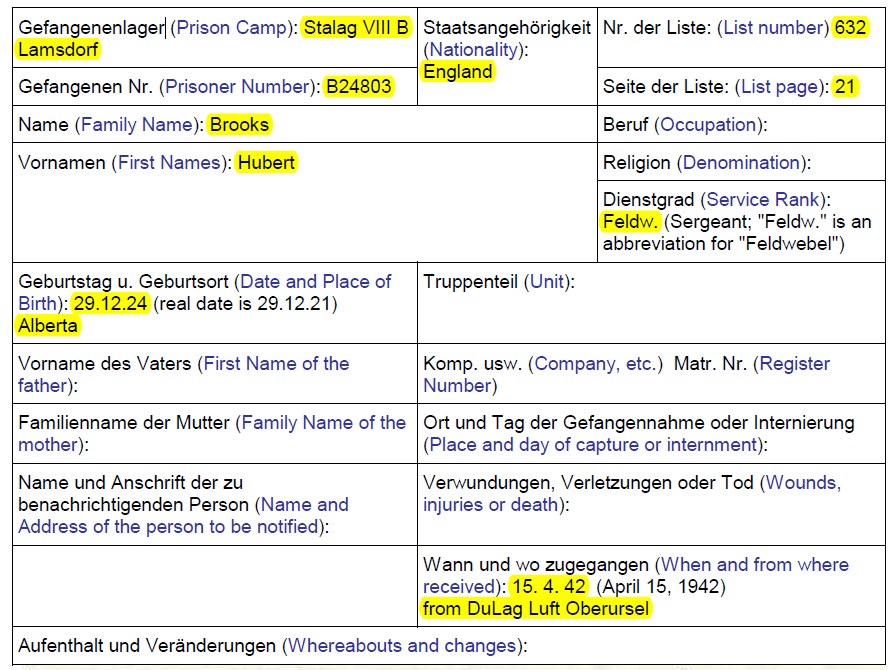
|
Early May 1942, newspaper accounts Ref: 2.7 first started to appear detailing that I was a PoW.
In early May 1942 the Deputy Minister of Canada's Department of National War Services sent my mother a letter officially telling her that I was a PoW.
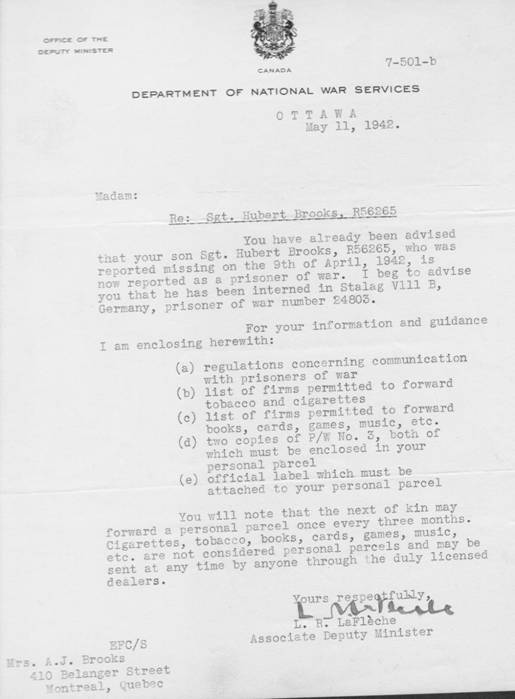
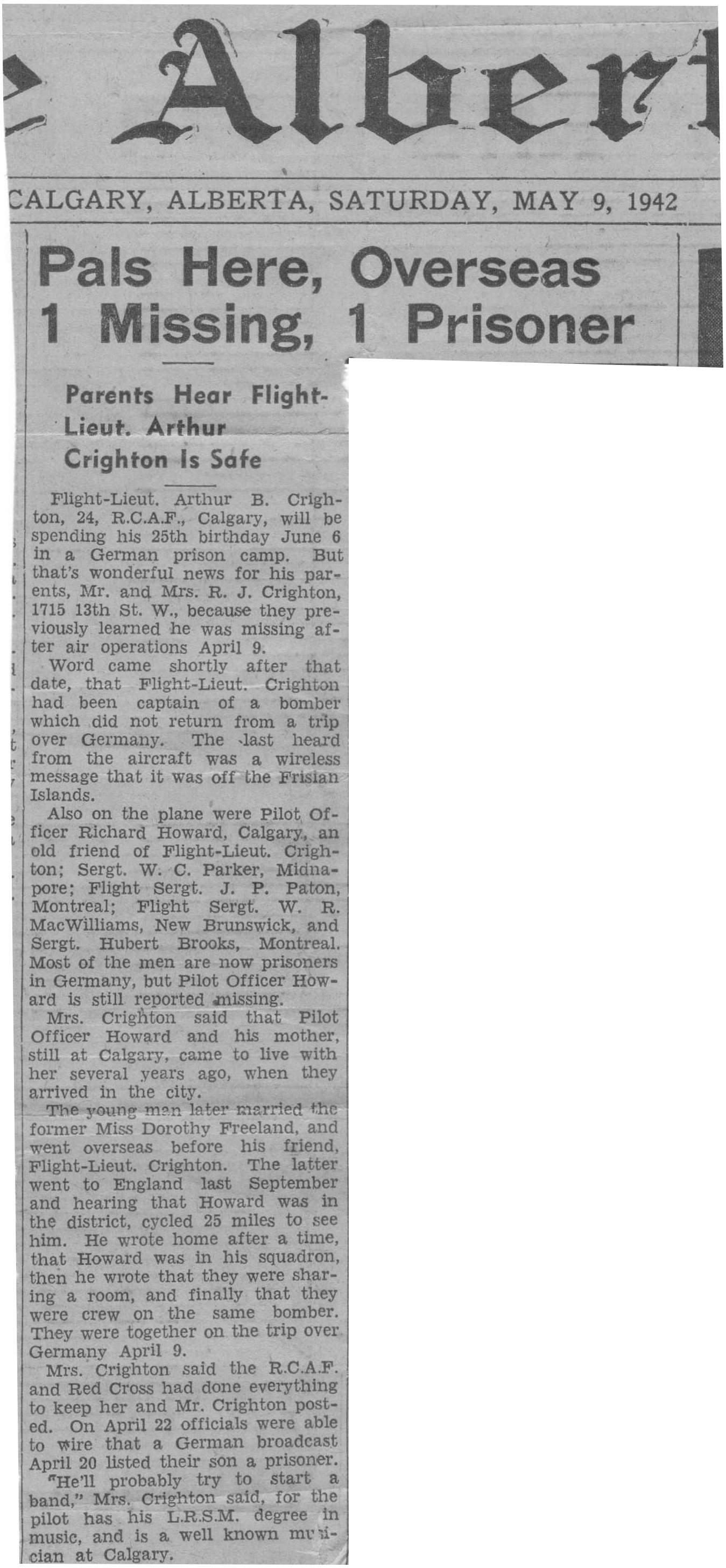
On 21–May–1942 the Military intercepted two letters from my Wellington crew mates telling of our capture:
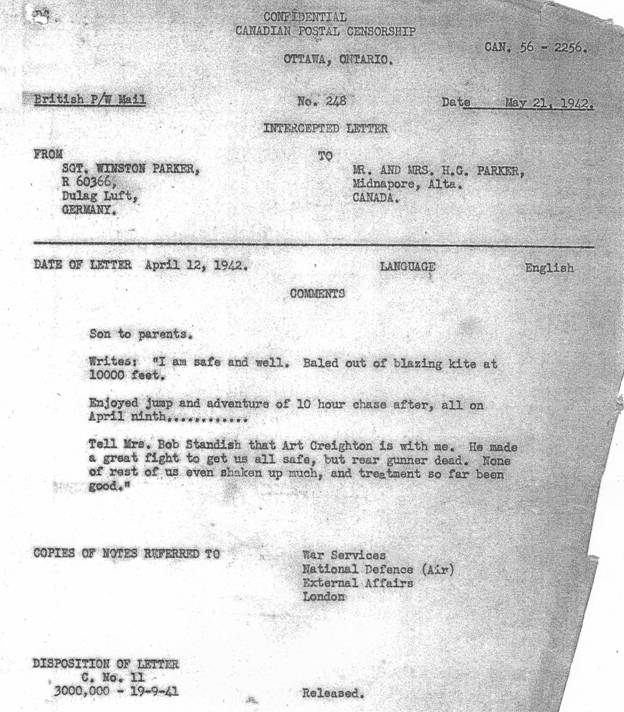
(Editor's Note For Winston Parker's full story in captivity see the web site The Long March. Winston also has a PERSONAL WEB SITE, where purchase details for his book Saddles and Service describing his life, including war time service, can be found.)

And shortly thereafter on 26–May–1942 they intercepted my letter to my folks back in Montreal. I did not want to worry them about my bad landing during my parachute bail out so I said nothing about it.
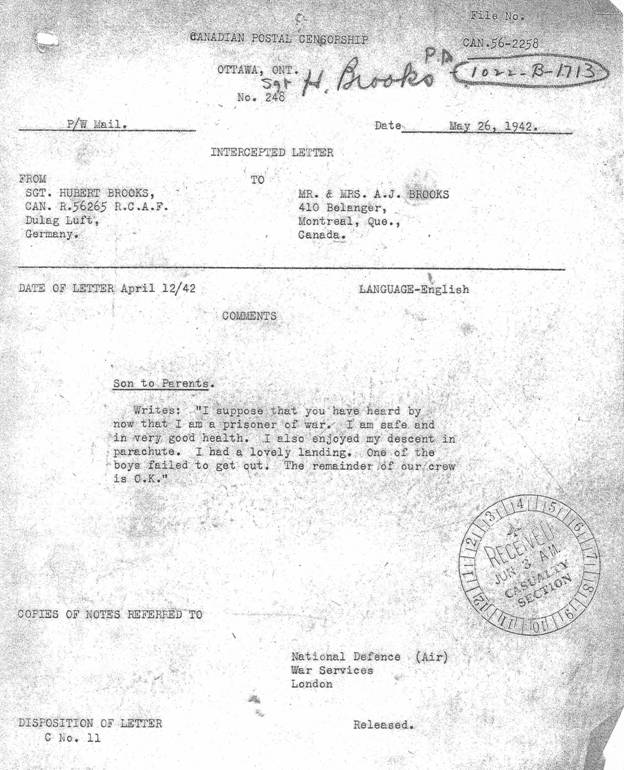
Followed by a letter from the Red Cross re–confirming I was a PoW and being held at StaLag Luft. I'm sure at the time my parents appreciated every letter and notice even if it only re–confirmed what had already been stated.
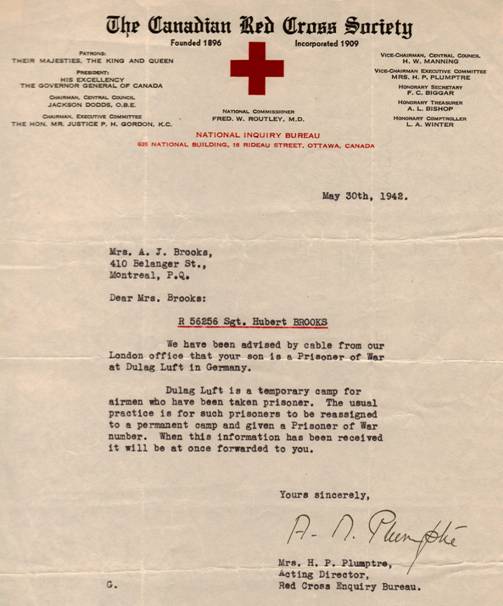
Sometime later in time, my mother received a letter from the Irving Air Chute Company telling her essentially that they were pleased that their product had worked and her son Hubert Brooks was now a member of the Caterpillar Club! I never did ask my mother how she reacted to this letter.

|
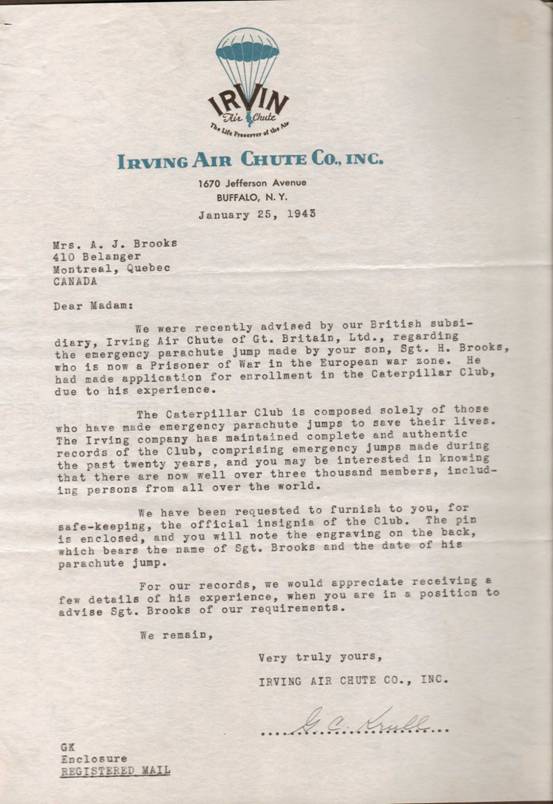
|

At the time, I wish I had known that all of these messages were actually getting through to my parents. I just did not know. Had my letter gotten through, had the Red Cross notified them and so on?
| PREVIOUS PAGE | GO TO TOP OF PAGE FOR INTER- and INTRA- CHAPTER NAVIGATION MENUS |
NEXT PAGE |
The Life and Times of Hubert Brooks M.C. C.D.